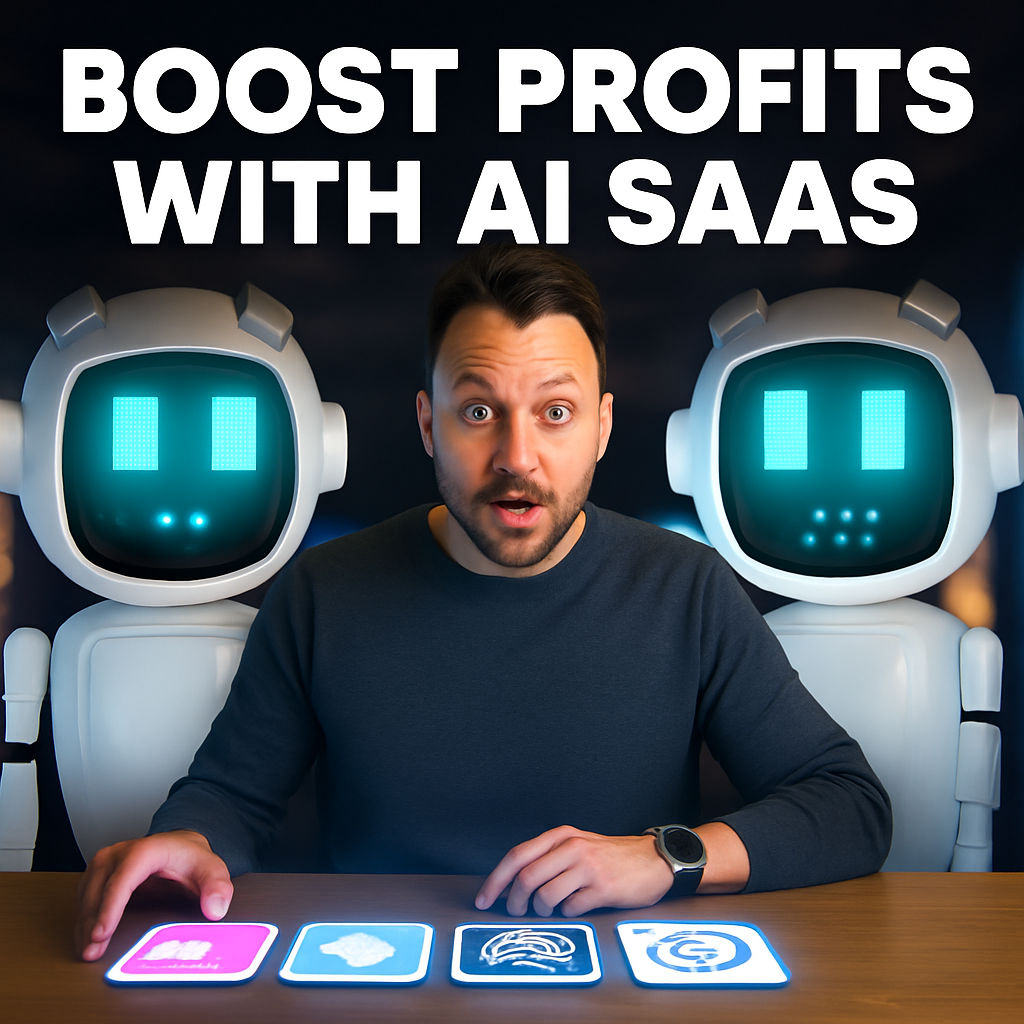Running a seven-figure SaaS business once required a sizable team—developers, designers, support, and operations staff. But with 2025’s explosion of AI tools, solo founders and lean teams are scaling revenue, cutting costs, and achieving incredible profit margins. If you’re fascinated by the idea of automating your SaaS business, this comprehensive guide will show you the eight highest-impact AI tools reshaping operations, support, content, and product development—all as demonstrated by a real SaaS founder raising both revenue and profit margins by nearly automating everything with AI.
Based on the original video:
Why Lean SaaS Teams Are Winning With AI in 2025
The primary topic here is the use of AI tools to automate and optimize SaaS business processes. In the last year, thanks to carefully chosen AI systems, a SaaS founder was able to grow total revenue from $1 million to 1.5x that amount, while reducing the entire staff headcount from nine to four people. How? By strategically adopting AI agents for customer support, content, operations, and development, the business achieved an impressive 90% profit margin—unheard of for most software companies. As AI tools keep maturing, even smaller teams and bootstrapped ventures can compete toe-to-toe with much bigger players.
Let’s walk through the eight most effective AI tools and strategies powering today’s most profitable SaaS models.
AI Chat Assistants: Your Multipurpose Conversational Co-Worker
Every modern SaaS operation needs a reliable, flexible AI chatbot for daily tasks: research, drafting emails, code suggestions, and even quick troubleshooting. Until recently, ChatGPT from OpenAI was the staple; now, worthy alternatives are proliferating:
- Claude: Preferred by some founders, but often underwhelming for coding or nuanced content.
- Gemini (by Google): Excels at map-related searches and local results.
- Llama: Open-source—the go-to choice for customization and privacy.
- DeepSeek: A new contender with quick, high-quality outputs.
Despite new players, the majority of founders still choose ChatGPT for everyday needs. However, the high monthly fee ($200/month) has become prohibitive. To maximize value, this founder now leverages Typing Minds, a clean chat UI that directly ties into your own OpenAI account—delivering full GPT capabilities with more economical usage.
Automating Workflows and Back-End Logic With AI Agents
SaaS businesses thrive on lean, automated processes. Here’s where n8n excels. While mainstream tools like Zapier and Make connect apps with simple drag-and-drop, n8n unlocks power for developers and technical founders:
- Drag-and-drop workflows plus coding flexibility
- Easily set up custom API endpoints for rapid prototyping
- Native integrations with a vast array of SaaS and AI tools—plus build your own “AI agent team”
With n8n, you can design a network of AI agents—each powered by different language models (like OpenAI’s GPT)—and combine them for highly complex business logic without the need for coding entire multi-branch workflows. This is a true game changer for back-end automation and adaptive task routing.
AI-Powered Customer Support: Speed, Scale, and Satisfaction
AI is transforming customer support—minimizing response times, reducing manual involvement, and boosting client satisfaction. For instantly deployable, scalable support, advanced systems allow you to:
- Train custom AI models on your company’s own documentation, website, PDFs, and videos
- Deploy chat widgets that serve as smart first-line contact on your pages
- Combine autonomous ticket/email processing with human oversight
Today’s most powerful systems let you both automate responses and offer “human in the loop” oversight for complex queries—keeping customer satisfaction high even as team sizes shrink. This approach is especially valuable for lean or bootstrapped companies managing growing user bases with limited staff.
For further reading on building your own appointment booking or support automation flows, the post AI-Powered Customer Service & Booking System explores proven workflows in real businesses using integrated AI agents for Gmail, WhatsApp, and website widgets.

Content Creation: Images, Video, and Beyond With Next-Gen AI Models
Modern SaaS marketing, branding, and education depend on high-quality images, videos, and multimedia—once a realm for large in-house teams or costly contractors. Today, a savvy founder with basic AI and digital skills can:
- Use Replicate to run and fine-tune open-source AI models (like Stable Diffusion, Flux, Fox) directly in the cloud
- Train custom “Lora” models for hyper-personalized assets (e.g., product shots, YouTube thumbnails)
- Leverage massive catalogs of preconfigured models for image, video, and sound generation
For video creators and content marketers, this means radically streamlined production—faster turnaround, lower costs, and almost limitless creative possibilities. Even advanced CGI and 3D effects are now within reach, without contracting a studio or learning to write complex code.
Fine-Tuning Visuals: Combining 3D, CGI, and AI
Founders often believe that advanced visuals require hiring a skilled VFX studio. In reality, you can use AI-driven tools to create CGI backgrounds, props, or effects—even recreating entire scenes in 3D—after a brief introduction to Blender or similar software. If a model’s output isn’t perfect, you can refine and direct the result with tools like ComfyUI:
- Node-based systems allow intricate mixing of models
- Pipe outputs (e.g., depth maps, outlines) from one model into another for tailored results
- Build control nets to guide image creation and environment recreation
This makes it possible even for non-artists to generate professional-looking clips. You can run ComfyUI in the cloud (e.g., with RunComfy) or install it locally for more direct control.

Empowering 2D to 3D Conversion With AI
Sometimes, you need to create basic 3D assets or scenes but lack the time or technical knowledge to start from scratch. Here, a lightweight AI tool like Sey Depth can take a generated 2D image and—using depth prediction—turn it into a realistic 3D mesh:
- Use AI for instant depth maps from 2D outputs
- Generate and refine meshes for 3D usage without manual sculpting
- Integrate with other AI image generation models (like Flux, Fox) to iterate quickly
The workflow for fast, high-quality SaaS content becomes clear: start with Replicate to get your raw visuals, enhance or customize further with ComfyUI, and easily generate depth/3D meshes with Sey Depth.
Smarter Product Development: AI Agents as On-Demand Developers
One of the biggest bottlenecks for SaaS teams has always been development: prototyping features, maintaining integrations, and iterating rapidly. In 2025, AI tools like n8n and flexible chat assistants are enabling founders to:
- Create functional API prototypes quickly with drag-and-drop and code-injection capabilities
- Assign exploratory research, small code generation, or bug-fixing to autonomous AI agents
- Empower even non-developers to solve backend challenges without full-stack engineers
These systems can dramatically cut product iteration cycles and reduce the need for a large R&D team—unlocking higher margins and faster feature releases.

Maximize Profit Margins With Fewer Human Inputs
The outlined approach doesn’t just increase efficiency—it allows SaaS founders to rethink their business models altogether. By drastically shrinking headcount while growing both revenue and capacity, the businesses employing these AI strategies are seeing:
- Profit margins rising near or above 90%
- Greater resilience to staff turnover and employment market shifts
- The freedom to iterate new products or pricing models without logistical barriers
- More time for high-value creative or strategic work
Teams are transitioning from manual, labor-intensive workflows to augmented, autonomous, AI-powered operations. If you’re building or scaling a SaaS company in 2025, adopting these tools isn’t just an optimization—it’s the new standard for sustainable, competitive growth.
Key Takeaways for Automating Your SaaS Business With AI
- Modern AI tools enable solo founders or small teams to efficiently run profitable SaaS businesses
- AI chat assistants remain indispensable for fast, flexible daily workflow support
- Next-gen workflow automation tools (like n8n) allow deep customization without large development teams
- Customer support, content creation, and development can now be mostly automated (or just AI-assisted) at scale
- Rapid adoption of these tools can unlock much higher profit margins and operational agility
Further Reading
AI-driven automation is unlocking new opportunities everywhere—from customer service to sales to product design. For more detailed strategies on monetizing automation, Monetize AI Agents & Automation in 2025 explores how AI workflows are now mainstream revenue-drivers.
FAQ
- How did the SaaS founder increase profit margins to 90%?
By reducing team size and automating essential services—support, content, and operations—with powerful AI tools, enabling a seven-figure business with only four employees. - Which AI tools are best for automating workflow in SaaS business?
High-impact tools include ChatGPT (via Typing Minds), Gemini, n8n for automation, Replicate for multimedia generation, ComfyUI for advanced image workflows, and Sey Depth for 2D-to-3D image conversion. - Can AI-powered support systems handle all customer requests?
Modern AI systems effectively manage most tickets and queries, but complex cases often still benefit from human oversight, especially in hybrid “AI plus human” workflows. - How can founders use AI for product development?
AI aids prototyping, code generation, integration, and bug-finding—enabling founders or small teams to iterate features quickly and affordably. - Is it possible to fully automate content creation with AI?
Yes, especially for visual previews, thumbnails, and even 3D assets. Founders can leverage AI for almost all digital content pieces with minimal manual intervention.









